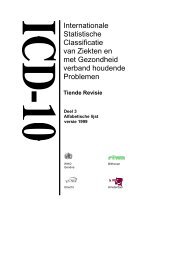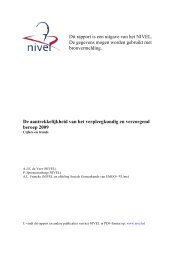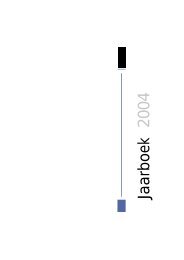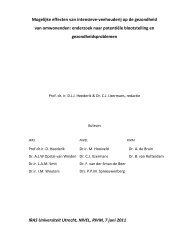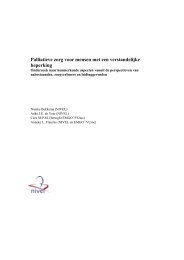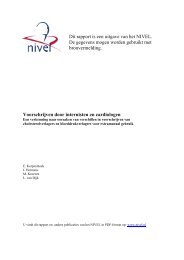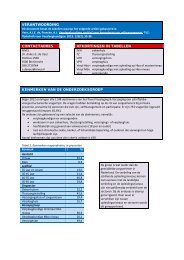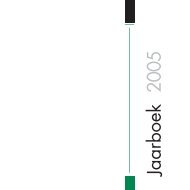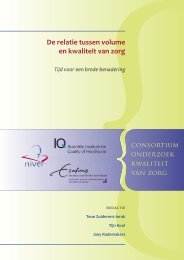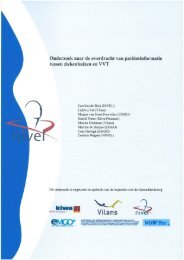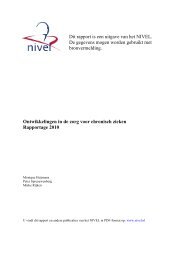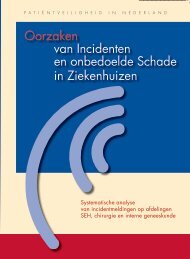Multi-Sensory Stimulation in 24-hour Dementia Care - Nivel
Multi-Sensory Stimulation in 24-hour Dementia Care - Nivel
Multi-Sensory Stimulation in 24-hour Dementia Care - Nivel
Create successful ePaper yourself
Turn your PDF publications into a flip-book with our unique Google optimized e-Paper software.
ut spread rather rapidly across Europe, <strong>in</strong> particular the United K<strong>in</strong>gdom, <strong>in</strong> the<br />
1980s and 1990s. It is just beg<strong>in</strong>n<strong>in</strong>g to appear <strong>in</strong> the United States (Chitsey et al.,<br />
2002). Snoezelen can be def<strong>in</strong>ed as an approach which actively stimulates the senses<br />
of hear<strong>in</strong>g, touch, vision and smell <strong>in</strong> a resident-oriented, non-threaten<strong>in</strong>g<br />
environment (Kok et al., 2000). It is <strong>in</strong>tended to provide <strong>in</strong>dividualized, gentle<br />
sensory stimulation without the need for higher cognitive processes, such as memory<br />
or learn<strong>in</strong>g, <strong>in</strong> order to achieve or ma<strong>in</strong>ta<strong>in</strong> a state of well-be<strong>in</strong>g. Traditionally,<br />
snoezelen was applied <strong>in</strong> a special room with an array of equipment, offer<strong>in</strong>g multiple<br />
stimulation, cover<strong>in</strong>g all the sensory channels (i.e., a vibrat<strong>in</strong>g bed, soft comfortable<br />
furnish<strong>in</strong>gs, aroma steamers, spotlights, mirrors and music), both to stimulate and to<br />
relax (Noorden, 1999; Lancioni et al., 2002). In the present study, snoezelen is<br />
extended to the <strong>24</strong>-h daily care. <strong>Care</strong>givers learn to <strong>in</strong>corporate personal<br />
circumstances of the residents such as lifestyle, preferences, desires and cultural<br />
diversity <strong>in</strong>to <strong>24</strong>-h daily care (Noorden, 1999). By <strong>in</strong>terview<strong>in</strong>g family members<br />
(‘history tak<strong>in</strong>g’) and systematic observations (‘stimulus preference screen<strong>in</strong>g’), the<br />
caregivers f<strong>in</strong>d out what stimuli the resident enjoy most (Lancioni et al., 2002).<br />
Then, the <strong>in</strong>formation is <strong>in</strong>tegrated <strong>in</strong> the residents’ care plan (‘snoezel care plan’).<br />
<strong>Care</strong>givers also learn to adapt their attitude and practical skills to <strong>in</strong>tegrate multisensory<br />
stimuli <strong>in</strong> the care. The ultimate goal of <strong>in</strong>tegrated snoezelen is, consistent<br />
with the concept of patient-centeredness, the caregivers’ understand<strong>in</strong>g of the<br />
residents’ real needs, preferences and wishes (Bens<strong>in</strong>g, 2000).<br />
Snoezelen aims to reduce residents’ maladaptive behaviours, to <strong>in</strong>crease positive<br />
behaviours and to improve their mood. Researchers describe the therapeutic benefits<br />
of snoezelen <strong>in</strong> terms of relaxation, behaviour modification or improved quality of life<br />
(Chitsey et al., 2002; Lancioni et al., 2002).<br />
Additionally, snoezelen is used <strong>in</strong> dementia care to promote a caregiv<strong>in</strong>g relationship<br />
and to reduce caregiv<strong>in</strong>g stress, assum<strong>in</strong>g a positive effect of the caregivers’ quality of<br />
work<strong>in</strong>g life (McKenzie, 1995; Savage, 1996; Chung, 2002).<br />
Effectiveness of snoezelen<br />
Until now, there has been limited evidence for the effectiveness of snoezelen. In the<br />
last decade, a number of studies have been carried out that evaluate the impact of<br />
snoezelen sessions <strong>in</strong> a special room on the resident’s behaviour as well as on adaptive<br />
and performance skills with<strong>in</strong> and after the snoezelen sessions. Although the majority<br />
of these studies did report with<strong>in</strong>-session positive effects, most of the studies were<br />
not methodologically sound, e.g., conta<strong>in</strong>ed no comparisons between treatment and<br />
control groups which are essential to demonstrate that snoezelen prevents<br />
deterioration (Lancioni, 2002). Chung et al. (2002) conducted a Cochrane review<br />
and found two randomised cl<strong>in</strong>ical trials (RCTs) of sufficient scientific quality,<br />
evaluat<strong>in</strong>g the effects of snoezelen <strong>in</strong> a snoezel room (Baker et al., 1997; 2001;<br />
Introduction 15



